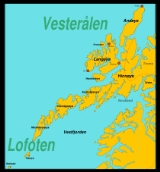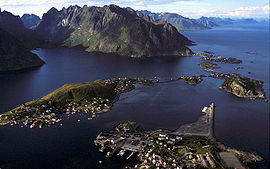
Moskenesøya
Encyclopedia
Moskenesøya is an island in Lofoten
in Nordland
county of Norway
. The island consists of an agglomeration of glaciated hills with the highest peak at 1029 metres (3,376 ft) (Mt. Hermannsdalstinden
). It is elongated from south-west to north east, is about 40 km long and 10 km wide, and has a very uneven shoreline. The island is shared by the municipalities of Moskenes
and Flakstad
and is connected to the nearby island of Flakstadøya
by a Kåkern Bridge
– a cantilever
road bridge of 303 meters length and 10 meters widths with concrete surface. It is part of the European route E10
which ends on the Moskenesøya island at the village named Å
.
The Flakstad municipality has the administrative center at Ramberg
– a village with the population of 350. The Moskenes municipality contains the villages of Å
, Hamnøy
, Moskenes, Reine
(administrative center, population 301), Sakrisøy, Sørvågen
(448 people) and Tind (population 30), all located on the eastern side of the island. There were settlements on the western coast, but the last ones were abandoned in 1950s owing to severe storms. Most villages are frequently visited by tourists and have designed small exhibits of local peculiarities. So Sakrisøy has a museum of 2,500 dolls from all over Europe. Sørvågen contains a local department of Norsk Telemuseum (Norwegian Telecom Museum) which reflects the local history of telegraphy. In 1861, the island became part of the 170 km long Lofoten telegraph line with a station in Sørvågen (which became the Sørvågen museum in 1914), and in 1867 the line was connected with Europe. In 1906, a wireless telegraph system was installed in Sørvågen – the second in Europe after Italy – connecting Sørvågen with Røst
island.
The village of Å is a traditional fishing place and nearly its entire territory is the 150 years old Norwegian Fishing Village Museum
, which includes the Lofoten Stockfish Museum
, a forge, a bakery and a cod liver oil factory.
In the beginning of World War II, the island was occupied by the German Army. In December 1941, it was the venue of the Operation Anklet
– a British Commando raid carried out by 300 men from No. 12 Commando
and the Norwegian Independent Company 1
. The landing party was supported by 22 ships from three navies – British, Norwegian and Polish. As a result, two German radio transmitters were destroyed and several small boats were captured or sunk. Importantly an operational Enigma coding machine
was obtained from one of the sunken German patrol ships. Also, about 200 local Norwegians volunteered to serve in the Free Norwegian Forces
.
Lofoten
Lofoten is an archipelago and a traditional district in the county of Nordland, Norway. Though lying within the Arctic Circle, the archipelago experiences one of the world's largest elevated temperature anomalies relative to its high latitude.-Etymology:...
in Nordland
Nordland
is a county in Norway in the North Norway region, bordering Troms in the north, Nord-Trøndelag in the south, Norrbottens län in Sweden to the east, Västerbottens län to the southeast, and the Atlantic Ocean to the west. The county was formerly known as Nordlandene amt. The county administration is...
county of Norway
Norway
Norway , officially the Kingdom of Norway, is a Nordic unitary constitutional monarchy whose territory comprises the western portion of the Scandinavian Peninsula, Jan Mayen, and the Arctic archipelago of Svalbard and Bouvet Island. Norway has a total area of and a population of about 4.9 million...
. The island consists of an agglomeration of glaciated hills with the highest peak at 1029 metres (3,376 ft) (Mt. Hermannsdalstinden
Hermannsdalstinden
Hermannsdalstinden is the highest mountain on the island Moskenesøya, in the archipelago Lofoten in North Norway....
). It is elongated from south-west to north east, is about 40 km long and 10 km wide, and has a very uneven shoreline. The island is shared by the municipalities of Moskenes
Moskenes
Moskenes is a municipality in Nordland county, Norway. The area of the municipality comprises the southern part of Moskenesøya. It is part of the Lofoten traditional region...
and Flakstad
Flakstad
Flakstad is a municipality in Nordland county, Norway. It is part of the Lofoten traditional region. The administrative centre of the municipality is the village of Ramberg...
and is connected to the nearby island of Flakstadøya
Flakstadøya
Flakstadøya is an island in Lofoten in Nordland county, Norway. It is located in Flakstad municipality.The island is connected to Moskenesøya in the west by Kåkern Bridge, and to Vestvågøya through the undersea tunnel Nappstraumtunnelen....
by a Kåkern Bridge
Kåkern Bridge
Kåkern Bridge is a cantilever road bridge that crosses Kåkernsundet between Flakstadøya and Moskenesøya in Nordland county, Norway. It is 303 metres long....
– a cantilever
Cantilever
A cantilever is a beam anchored at only one end. The beam carries the load to the support where it is resisted by moment and shear stress. Cantilever construction allows for overhanging structures without external bracing. Cantilevers can also be constructed with trusses or slabs.This is in...
road bridge of 303 meters length and 10 meters widths with concrete surface. It is part of the European route E10
European route E10
European route E 10 is a road part of the International E-road network. It begins in Å, Norway and ends in Luleå, Sweden. The road is about 850 km in length...
which ends on the Moskenesøya island at the village named Å
Å, Moskenes
-Overview:Å is traditionally a fishing village, specialising in stockfish, but now also features tourism.The town contains the Lofoten Stockfish Museum and the Norwegian Fishing Village Museum....
.
The Flakstad municipality has the administrative center at Ramberg
Ramberg, Flakstad
Ramberg is the administrative centre of Flakstad municipality, in the Lofoten islands, Nordland, Norway. It is located on the island Flakstadøya and has approximately 350 inhabitants,....
– a village with the population of 350. The Moskenes municipality contains the villages of Å
Å, Moskenes
-Overview:Å is traditionally a fishing village, specialising in stockfish, but now also features tourism.The town contains the Lofoten Stockfish Museum and the Norwegian Fishing Village Museum....
, Hamnøy
Hamnøy
Hamnøy is a populated island in Moskenes municipality, Norway.Hamnøy was previously connected to Reine by ferry, but this has been replaced by bridges on European route E10....
, Moskenes, Reine
Reine
Reine is the administrative centre of Moskenes municipality, Norway. Its population is 342. It has been a commercial centre since 1743. Today tourism is important. In spite of its remote location thousands of people visit this neighborhood annually....
(administrative center, population 301), Sakrisøy, Sørvågen
Sørvågen, Moskenes
Sørvågen is a fishing village in Moskenes municipality on Lofoten, Norway with several scenery attractions.Sørvågen contains a local department of Norsk Telemuseum which reflects the local history of telegraphy...
(448 people) and Tind (population 30), all located on the eastern side of the island. There were settlements on the western coast, but the last ones were abandoned in 1950s owing to severe storms. Most villages are frequently visited by tourists and have designed small exhibits of local peculiarities. So Sakrisøy has a museum of 2,500 dolls from all over Europe. Sørvågen contains a local department of Norsk Telemuseum (Norwegian Telecom Museum) which reflects the local history of telegraphy. In 1861, the island became part of the 170 km long Lofoten telegraph line with a station in Sørvågen (which became the Sørvågen museum in 1914), and in 1867 the line was connected with Europe. In 1906, a wireless telegraph system was installed in Sørvågen – the second in Europe after Italy – connecting Sørvågen with Røst
Røst
Røst is a municipality in Nordland county, Norway. It is part of the Lofoten traditional region. The administrative centre of the municipality is the village of Røst. Røst was separated from the municipality of Værøy on 1 July 1928.- Environment :...
island.
The village of Å is a traditional fishing place and nearly its entire territory is the 150 years old Norwegian Fishing Village Museum
Norwegian Fishing Village Museum
The Norwegian Fishing Village Museum is a museum devoted to Norwegian fishing in the village of Å, Moskenes in the municipality of Moskenes, in Lofoten in north-west Norway....
, which includes the Lofoten Stockfish Museum
Lofoten Stockfish Museum
Lofoten Stockfish Museum is a museum devoted to Norwegian fishing and stockfish. The museum is located in the village of Å i Lofoten in the municipality of Moskenes, in the Lofoten islands in the county of Nordland, Norway. Norway...
, a forge, a bakery and a cod liver oil factory.
In the beginning of World War II, the island was occupied by the German Army. In December 1941, it was the venue of the Operation Anklet
Operation Anklet
Operation Anklet was the codename given to a British Commando raid during the Second World War. The raid on the Lofoten Islands was carried out in December 1941, by 300 men from No. 12 Commando and the Norwegian Independent Company 1. The landing party was supported by 22 ships from three navies.At...
– a British Commando raid carried out by 300 men from No. 12 Commando
No. 12 Commando
No. 12 Commando was a battalion-sized commando unit of the British Army during the Second World War. Formed in 1940 in Northern Ireland, they carried out a number of small-scale raids in Norway and France between 1941 and 1943 before being disbanded and its personnel dispersed to other commando...
and the Norwegian Independent Company 1
Norwegian Independent Company 1
Norwegian Independent Company 1 was a British SOE group formed in March 1941 originally for the purpose of performing commando raids during the Occupation of Norway by Nazi Germany. It was organized under the leadership of Captain Martin Linge...
. The landing party was supported by 22 ships from three navies – British, Norwegian and Polish. As a result, two German radio transmitters were destroyed and several small boats were captured or sunk. Importantly an operational Enigma coding machine
Enigma machine
An Enigma machine is any of a family of related electro-mechanical rotor cipher machines used for the encryption and decryption of secret messages. Enigma was invented by German engineer Arthur Scherbius at the end of World War I...
was obtained from one of the sunken German patrol ships. Also, about 200 local Norwegians volunteered to serve in the Free Norwegian Forces
Free Norwegian Forces
The Norwegian Armed Forces in exile were remnants of the armed forces of Norway that continued to fight the Axis powers from Allied countries, such as Britain and Canada, after they had escaped the German occupation of Norway during World War II.-Background:...
.
 |
 |
 |
||
| Reine | Reine | Hamnøy | Norwegian Telecom Museum in Sørvågen |
Village Å |

